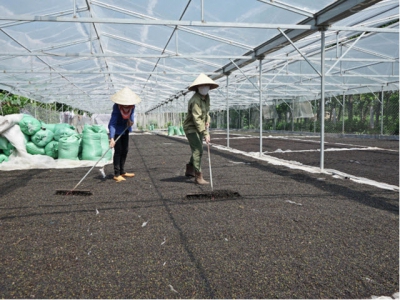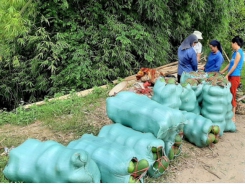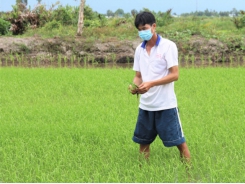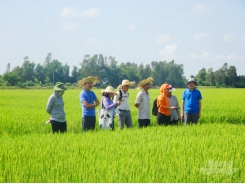To get 1 ton of coffee and pepper, what have the plants taken away from soil?

Fertilizing multi-factor NPK Van Dien for coffee and pepper after harvest will help improve quality and promote their brand names to the world.
Van Dien fertilizer has become a “familiar friend” of pepper growers over the years. Photo: TL.
Characteristics of soil for growing coffee and pepper
Coffee and pepper are crops with high economic grown mainly on red basalt soil and part of gray soil. Central Highlands region has the largest area for coffee and pepper cultivation with nearly one million hectares. Besides valuable characteristics such as thick cultivation layers, porousness, well-drainage, the plateaus region usually has a temperate climate with two distinct dry and rainy seasons. However, red basalt and gray soils also show many weaknesses such as poor phosphorus, easily being degraded, poor calcium, magnesium, silica and lack of trace elements, typically zinc and boron.
According to researches, to have 1 ton of green coffee, the plants take away from the soil about 40kg of N, 26.5kg of P2O5, 30.7kg of K2O, 2.5 - 3.5kg of CaO, 2.0kg of MgO, 8 - 12g of B and 12 - 18g of Zn… Thus, coffee needs a lot of nutrients.
For pepper to have 5 tonnes of products/ha, the plants take away a certain amount of nutrients including 190kg of N, 105kg of K2O, 60kg of P2O5, 25kg of CaO, 41kg of MgO, 15kg of S, 16kg of SiO2, 1.5 kg of B and 2kg of Zn.
Like coffee, pepper also consumes dozens of nutrients from the soil. In order to provide enough nutrients for the plant, farmers must supplement with fertilizers so that to balance the quality that the plant has taken away from the soil every year.
After more than ten years of research, the Central Highlands Agro-Forestry Science and Technology Institute announced that Van Dien fertilizer has the highest amount of nutrients and is especially effective for coffee and pepper growing on Basalt red and gray soils.
The scientific works also focused on the most effective fertilization periods in the yearly crops. Post-harvest fertilizing is very especially important and indispensable for coffee and pepper.
After many years, Van Dien Fused Phosphate Fertilizer Company, in collaboration with scientists and gardeners, has successfully experimented and identified the dose and method of fertilizing for coffee and pepper effectively in the post-harvest.
Van Dien fused phosphate fertilizer
Van Dien fertilizer is produced from the main materials of apatite ore containing 28 - 32% of total P2O5, Sepentin ores containing CaO, MgO, Fe, B, Zn, Cu, Co... and sandstone containing 67% of silica, a mixture of three ores melted at 1,450 degrees Celsius, converting nutrients in three ores into three types of phosphate that are completely digestible and easy to use by plants. Due to the physical method of melting, no chemicals are used, so the calcined phosphate fertilizer is non-toxic and is an environmentally friendly mineral fertilizer.
Van Dien fused phosphorus has the following nutrients: Phosphorus (P2O5) = 16%; Lime (CaO) = 30%; magnesium (MgO) = 15%; Silicon (SiO2) = 24%; Bo (B) = 0.04%; zinc (Zn) = 0.02%; Iron (Fe) = 0.04%; Copper (Cu) = 0.01%; Magan (Mn) = 0.02%... Total plant nutrients can be absorbed up to 98% in Van Dien fused phosphorus.
Van Dien phosphate raw materials combined with nitrogen, potassium, and sulfur on modern production lines, dried color pellets have made up various ĐYT fertilizer products specialized for coffee and pepper.
Van Dien fertilizing technique for coffee after harvest
After harvest, the plants’ health will decline, showing in old hairy roots and degraded leaves. Gardeners’ task is to restore the plants by taking care of them by fertilizing them to easily rejuvenate them at the same time enhance the photosynthesis for leaves.
The caring world should be carried out 15-20 days after harvest including cleaning the garden, picking weeds from the tub, collecting dead and decayed branches, cutting and pruning the overhanging branches to open for canopy, then digging a ditch 15-20cm wide and 5cm- 10cm deep around the projection of foliage, raking the soil on the surface of the basin and apply a certain amount of fertilizer for each root.
After 20 - 30 days of fertilizing, the roots will grow fast, the absorption of nutrients will increase, leaves will return to a glossy green color with better photosynthesis.
Note: Depending on the age of the tree and the fertility of the soil, farmers should adjust the amount of fertilizer. A good amount of fertilizer will help the plant prepare to enter the flower sprout differentiation, bloom, pollinate and bear fruit.
Van Dien fertilizing technique for pepper after harvest
The pepper plant has different characteristics from coffee. It has hairy roots much older and regenerated slowly. The hairs are thin and brittle, easy to crack and are susceptible to diseases so the plants die quickly because the virus penetrates through the cracks of the bristles. The roots should not be damaged so soil disturbance should be limited around the root zone as far as the canopy projection. After fruit collection, farmers should clean the garden, prune to create ventilation, and cut down old, dry and disease-infected branches.
Growers should prepare organic manure or dried cattle manure, absolutely do not use fresh, unrotted manure. Use 20 - 25 kg of rotting organic fertilizer + 2.0 kg of Van Dien phosphate + 0.2 - 0.4 kg/post NPK 12.8.12 or 0.3 - 0.4 kg/post or 0.3 - 0.5 kg TYK NPK 10.10.5.
Applying fertilizer floating on the top of the tank for pepper will help safely protect all old hairy roots and develop new hairy roots for the plants. Depending on the specific conditions of each garden such as soil fertility, age of plants, annual yield of the previous year crop, farmers can adjust for the appropriate amount of fertilizer following principles that caring for pepper plants is like caring for "children”.
Van Dien multi-factor fertilizer provides up to 13 nutritional elements for coffee and pepper, including three macronutrients N-P-K in balance according to the plant growing after harvest and also provides enough 4 intermediate calcium elements (CaO), magnesium (MgO), silicon (SiO2), and sulfur (S). For microelements, it contains full of 6 essential elements of boron, zinc, manganese, copper, iron, and cobalt.
Coffee and pepper plants can recover health immediately after harvest in a short time to enter the stage of flower differentiation, develop young roods and help leaves to be well photosynthetic under the sunlight, creating good quality and high yield for the products at the same time reducing infection of pests and diseases thus reducing the use of pesticides, and environmental pollution but protecting and improving the fertility of the soil.
Related news
Tools

Phối trộn thức ăn chăn nuôi

Pha dung dịch thủy canh

Định mức cho tôm ăn

Phối trộn phân bón NPK

Xác định tỷ lệ tôm sống

Chuyển đổi đơn vị phân bón

Xác định công suất sục khí

Chuyển đổi đơn vị tôm

Tính diện tích nhà kính

Tính thể tích ao




 Asia rice - India rates hit three-month low,…
Asia rice - India rates hit three-month low,…  Farmers get more profits when applying farming techniques…
Farmers get more profits when applying farming techniques…